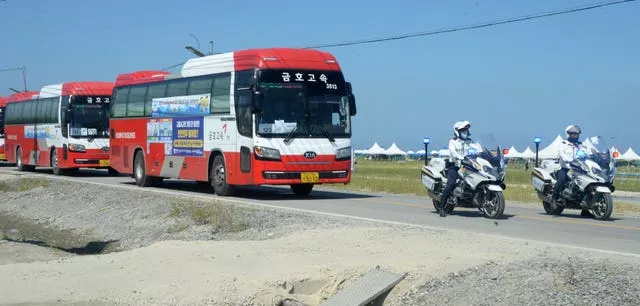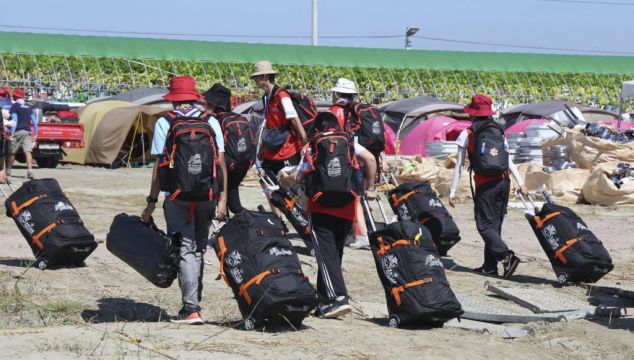Tens of thousands of Scouts began arriving at university dormitories, government and corporate training centres, and hotels around Seoul and other inland cities on Tuesday as the South Korean government evacuated the World Scout Jamboree ahead of a tropical storm.
The South Korean government had scrambled to keep the 12-day gathering of Scouts going in the face of heat, hygiene and land use controversies, as thousands of British and US Scouts departed over the weekend.
It was not until Monday that officials announced the decision to abandon the coastal campsite in Saemangeum, a huge area reclaimed from the sea in the southwestern county of Buan, after forecasters said tropical storm Khanun was heading toward the Korean Peninsula.
Nearly 40,000 participants have now safely departed from the 25th World #ScoutJamboree thanks to the Korean Government, supported by hundreds of volunteer #Scouts on the ground! 👏
Here's an update from our Secretary General @AhmadAlhendawi: pic.twitter.com/cfh7RQkcC1— World Scouting (@worldscouting) August 8, 2023
Advertisement
As of Tuesday, tropical storm Khanun was passing through waters 36 miles south of Japan’s Yakushima island, which is south of the southern main island of Kyushu.
Japan’s weather agency issued warnings for heavy rain and high winds in the southern regions of Kyushu and parts of Shikoku island, east of Kyushu.
The 37,000 Scouts, from 156 countries and mostly teenagers, folded up their tents before boarding more than over 1,000 vehicles for the evacuation that began on Tuesday morning.

The World Organisation of the Scout Movement later said all youth participants had safely left the Jamboree campsite.
Most of the Scouts will be accommodated in Seoul and the surrounding area.
South Korean officials say the Jamboree will continue in the form of cultural events and activities, including a K-Pop concert in Seoul on Friday.
Hundreds of scouts from Norway had already left the site on Monday, citing concerns about the complications of moving together with tens of thousands of other Scouts.

Geir Olav Kaase, leader of the Norwegian contingent, said the Scouts arrived at their hotels in Incheon by 9pm on Monday.
The 1,500-member Swedish contingent was transferred to three university dormitories in the central city of Cheonan.
Northern European countries are dealing with their own extreme weather, with strong winds and rains causing floods, damaging buildings and knocking out electricity at thousands of homes in Norway and Sweden, Denmark, Lithuania, Finland, Estonia and Latvia.
The North Jeolla provincial government, which governs Buan, had hoped that the Jamboree would draw attention and investment to a piece of controversial reclaimed land.
Concerns had been raised beforehand about having such large numbers of young people in a vast, treeless area lacking protection from the heat, as South Korea grappled with one of its hottest summers in years.

After the Jamboree began, hundreds of people were treated for heat-related ailments.
The South Korean government said the event was safe enough to continue and channelled resources to keep it going, adding medical staff, air-conditioned buses, military shade structures and hundreds of workers to maintain bathrooms and showers, which some Scouts had complained were filthy or unkempt.
Saemangeum is the result of a 19-year project to build a 21-mile seawall, which South Korea describes as the world’s longest.
Since the wall was finished in 2010, the land the wall helped to reclaim from the sea remains largely barren.
Once seen as a major development project for a region lacking an industrial base, it is now increasingly viewed as an ecological blunder that wiped out coastal wetlands and hurt fisheries production.

Local government officials say the project remains key to the region’s economic future, despite its failure to deliver on early promises.
Organisers said the campsite will not be used for any other events after the Scouts leave.
Tropical storm Khanun has meandered around Japan’s southwestern islands for more than a week, dumping heavy rain, knocking out power and damaging homes.
South Korea’s weather agency, which measured the storm at typhoon strength with maximum winds of 78 mph on Tuesday, expected it to gain strength slightly before making landfall on Thursday.
It is expected to bring strong winds and heavy rains to South Korea from Wednesday to Friday.
While all events come with their fair share of challenges, this event came with many extraordinary ones. It is the first time in over 100 years history of World Scout Jamborees to face such compounded challenges, from untimely floods to an unprecedented heatwave and now a… pic.twitter.com/1ElmnolcRM
— Ahmad Alhendawi (@AhmadAlhendawi) August 7, 2023
In an emergency meeting to discuss the storm on Tuesday, South Korean president Yoon Suk Yeol called for officials to be aggressive with disaster prevention measures, including evacuations of residents in risk areas, to prevent injuries or deaths.
He also said the country will do its “utmost” to ensure the safety of the Scouts so that they can “return home with good memories”.
South Korea’s ministry of the interior and safety instructed officials to prepare to shut down coastal areas, hiking trails, river parks, underpass tunnels and other places vulnerable to flooding.
More than 270 police cars and four helicopters were deployed to escort the buses transporting the Scouts, said interior and safety minister Lee Sang-min.
“This is the first time in more than 100 years of World Scout Jamborees that we have had to face such compounded challenges,” said Ahmad Alhendawi, secretary general of the World Organisation of the Scout Movement, who credited South Korea’s government with “mobilising all available resources” into the relocation effort.
“It’s disappointing that these adverse weather conditions have forced us to shift our plans,” he said.







